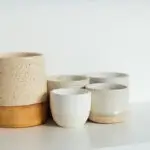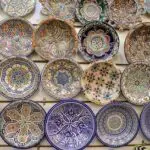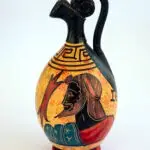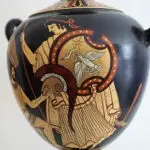Mediterranean pottery traditions have a rich history that dates back thousands of years, as archaeological research has shown. Throughout the Mediterranean, the region has been a hub of cultural exchange and trade for centuries, resulting in a diverse range of pottery styles and techniques. From the ancient Greeks to the Romans, the Mediterranean has long been known for its exquisite ceramic pottery.
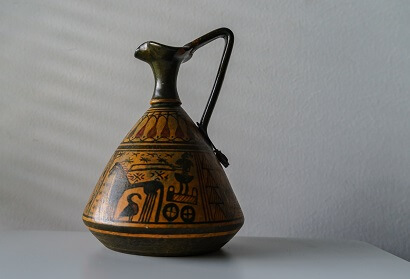
Greek pottery, a renowned Mediterranean tradition, captivates scholars and collectors. Its intricate designs and craftsmanship mesmerize. This versatile pottery served various functions, including storage and memorialization. Its depictions of Greek mythology offer glimpses into ancient Greek culture and beliefs. Motif designs added aesthetic allure and symbolic significance.
Terracotta pottery is a notable Mediterranean tradition that dates back thousands of years. It served both practical and decorative purposes, used for storing food and water while featuring intricate designs. Even today, terracotta pottery remains popular due to its durability and timeless aesthetic.
Famous Mediterranean Pottery Regions
Mediterranean pottery has a rich tradition that dates back thousands of years. The region is home to some of the most famous pottery traditions in the world. In this section, we’ll explore some of the most famous Mediterranean pottery regions.
Greece
Greece, particularly Athens, and Corinth, is one of the most famous pottery regions in the Mediterranean. Greek pottery has a long and rich history, with many famous styles and traditions. Some of the most famous ancient Greek pottery styles include Minoan, Cycladic, Corinthian, and Mycenaean. These styles are known for their intricate designs, vibrant colors, and beautiful shapes.
Italy
Italy is another famous Mediterranean pottery region. Italian pottery is known for its elegance and sophistication. Some of the most famous Italian pottery styles include Majolica, Faenza, and Deruta. These styles are known for their intricate patterns and beautiful colors.
Cyprus
Cyprus is a small island in the eastern Mediterranean. The island has a long history of pottery making, dating back thousands of years. Cypriot pottery is known for its intricate designs and beautiful colors. Some of the most famous Cypriot pottery styles include Red Polished Ware and White Painted Ware.
Near East
The Near East is another famous Mediterranean pottery region. The region includes countries like Turkey, Syria, and Lebanon. Near Eastern pottery is known for its intricate designs and beautiful colors. Some of the most famous Near Eastern pottery styles include Uruk, Halaf, and Ubaid.
In conclusion, the Mediterranean region is home to some of the most famous pottery traditions in the world. From Greece to Italy, Cyprus to the Near East, each region has its own unique style and history. Whether you’re a collector or simply appreciate the beauty of pottery, the Mediterranean has something for everyone.
Traditional Shapes and Forms
Mediterranean pottery has a rich history of traditional shapes and forms that have been passed down through generations of potters. These shapes and forms are not only functional but also aesthetically pleasing, making them popular among collectors and enthusiasts alike. In this section, we will explore some of the most common traditional shapes and forms of Mediterranean pottery.
Storage Vessels
Storage vessels are one of the most common forms of traditional Mediterranean pottery. These vessels are used to store grains, liquids, and other food items. They come in various shapes and sizes, including jars, amphoras, and urns. These vessels are usually made with a wide body and a narrow neck, making them easy to store and transport. Handles are also commonly incorporated into the design to make them easier to carry.
Mixing Vessels
Mixing vessels are another common form of traditional Mediterranean pottery. These vessels are used for mixing and preparing food items. They come in various shapes and sizes, including bowls, dishes, and plates. These vessels are usually made with a wide body and a flat bottom, making them ideal for mixing and kneading dough. Handles are also commonly incorporated into the design to make them easier to hold.
Cooking Utensils
Cooking utensils are an essential part of traditional Mediterranean pottery. These utensils are used for cooking and serving food items. They come in various shapes and sizes, including pots, pans, and casseroles. These utensils are usually made with a wide body and a flat bottom, making them ideal for cooking over an open flame. Handles are also commonly incorporated into the design to make them easier to hold.
Decorative Pieces
Decorative pieces are another popular form of traditional Mediterranean pottery. These pieces are used to decorate homes and other living spaces. They come in various shapes and sizes, including vases, plates, and figurines. These pieces are usually made with intricate designs and patterns, making them aesthetically pleasing. Handles are not commonly incorporated into the design of these pieces, as their primary function is decorative.
In conclusion, traditional Mediterranean pottery has a rich history of functional and aesthetically pleasing shapes and forms. From storage vessels to decorative pieces, these forms have been passed down through generations of potters, making them an important part of Mediterranean culture.
Greek Pottery Styles
Greek pottery has a rich history that spans centuries and has influenced the art world in many ways. The pottery styles of ancient Greece are characterized by their intricate designs, shapes, colors, and silhouettes. Three of the most popular Greek pottery styles are black-figure pottery, red-figure pottery, and geometric pottery.
Black-figure Pottery
Black-figure pottery is a style of pottery that was popular in ancient Greece from the 7th century BC to the 5th century BC. This style of pottery is characterized by its black figures on an orange-red background. The black figures were created by painting the design onto the pottery with a slip that turned black when fired. This technique allowed for intricate designs and details, including human figures, to be added to the pottery.
The black-figure technique was used to create a variety of pottery shapes, including amphorae, kraters, and hydriae. These shapes were often used for storing and transporting wine, water, and other liquids. Some of the most famous black-figure pottery pieces are the Francois Vase and the Dipylon Amphora.
Red-figure Pottery
Red-figure pottery is another popular style of pottery that was used in ancient Greece from the 6th century BCE to the 4th century BCE. This style of pottery is characterized by its red figures on a black background. The red figures were created by painting the design onto the pottery with a slip that turned red when fired. This technique allowed for more detailed designs and a wider range of colors to be used.
Like black-figure style pottery, red-figure pottery was used to create a variety of shapes, including amphorae, kraters, and hydriae. Some of the most famous red-figure pottery pieces are the Kylix and the Berlin Painter’s Amphora.
Geometric Pottery
Geometric pottery is a style of pottery that was used in ancient Greece from the 9th century BCE to the 8th century BCE. This style of pottery is characterized by its geometric designs, including circles, triangles, attic, and zig-zags. The designs were created using a variety of techniques, including incising and painting.
Geometric pottery was used to create a variety of shapes, including amphorae, kraters, and hydriae. Some of the most famous geometric pottery pieces are the Dipylon Amphora and the Lefkandi Centaur.
In conclusion, Greek pottery styles are a testament to the creativity and skill of ancient Greek artists. The black-figure, red-figure technique, and geometric pottery styles are just a few examples of the many styles that were used in ancient Greece. These pottery styles continue to inspire artists and Greek art lovers around the world today.
Pottery Trade
The mediterranean pottery trade has a long history, dating back to the Bronze Age. The Mediterranean region has always been a hub of trade activity, and pottery has been a significant part of this trade. The pottery trade was a crucial factor in the development of the Mediterranean economy, and it played a vital role in shaping the culture and civilization of the region.
Trade Routes
The Mediterranean region was a center of trade activity for centuries, and it was connected to the rest of the world through various trade routes. The pottery export was an essential part of these trade routes. The pottery was transported from one place to another through land and sea routes. The sea routes were particularly important, and they connected the Mediterranean region to other parts of the world. The most important sea routes were the Red Sea route, the Black Sea route, and the Aegean Sea route.
Demand
The demand for pottery was high in the Mediterranean region, and it was used for various purposes. Pottery was used for cooking, storage, and decoration. Pottery was also used for trade purposes, and it was an important commodity in the Mediterranean economy. The demand for pottery was high because it was durable, easy to transport, and it could be produced in large quantities.
Innovation
The pottery trade also played a significant role in the innovation of pottery shapes and forms. The pottery shapes and forms were influenced by the trade activity in the region. The pottery shapes and forms were also influenced by the cultural and social changes in the region. The pottery makers were always looking for new and innovative shapes and forms to meet the changing demands of the market.
In conclusion, the ceramics pottery trade was a crucial factor in the development of the Mediterranean economy, and it played a vital role in shaping the culture and civilization of the region. The pottery trade was influenced by various factors such as war, trade, demand, and innovation. The pottery trade was an essential part of the Mediterranean economy, and it contributed to the growth and prosperity of the region.
- The Top Restaurants Specializing in Truffle Dishes - August 10, 2023
- Truffle Panna Cotta: A Decadent Dessert Recipe for Truffle Lovers - August 7, 2023
- Truffle Scrambled Eggs: A Luxurious Breakfast Delight - August 7, 2023

